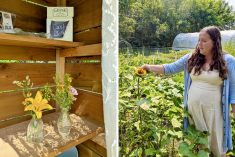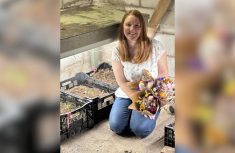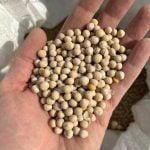After five years as owner-operator of flower farm Shifting Blooms, Raney’s long-time love of chickens is paying off more than she initially thought.
The mix of Ameraucana, Easter Egger, Swedish flower hens, Copper Marans, silkies, an Orpington and a Polish chicken create a rainbow of eggs for her farm stand. But her chickens give so much more than eggs.
“I realized how good their litter was for the garden,” says Raney. “It just made sense to try to increase our number of chickens so that we would have a fighting chance at fertilizing most of the garden.”
Read Also

It doesn’t have to be the end for your farm
Options for farmers without successors to pass on the farm.
Raney cleans out her coops twice a year, once in the spring after the snow melts and once in late fall. As she notes on her gardening blog, she quickly noticed a big difference in the quality of the soil.
“The soil in my pumpkin patch is pretty bad, but before planting, I put manure in each plant hole and then I put well-rotted chicken bedding in my garden early in the season. Unfortunately, I could only fill about half of the holes, but a few weeks later you could see a big difference in the pumpkins that got the chicken manure versus those that did not.”
The chickens are free to roam through the gardens, spread their manure, and eat bugs and grass. This saves Raney mowing time and has reduced bug pressure on her flowers during peak growing season.
“We don’t have ticks in our yard. The chickens also eat pretty much all the lily beetles. They don’t get every grasshopper, but they do get a good chunk of them,” Raney says.

Given all the benefits, she gladly puts up with the challenges of her flock.
For instance, they can be quite destructive. When there were only three birds, she didn’t notice as much destruction compared to the current 50-bird flock.
Raney tries to make the most out of Saskatchewan’s short growing season, so she starts as many plants as she can before the snow has even melted.
But for chickens, these newly emerged seedlings are delicious treats. This past year, they nibbled on the trays of the pink and purple flowers Raney was planning to use for winter advent wreaths.
Chicken wire has become Raney’s best friend.
“If I want it to live, I have to put chicken wire around it. When I have seedlings in the garden, I’ll just temporarily fence off those sections, row by row, and then once the plants reach a certain height, I take everything away.”
Chicken politics
Chicken politics also make for interesting developments.
Raney hasn’t noticed any separation by breed, but birds who hatch around the same time will stick together and amalgamate into the rest of the flock over the winter. Until then, the chickens have their own hierarchy and the term “pecking order” is no joke.
There are currently four roosters — too many, says Raney, if she wants a harmonious coop. “Some seasons it’s like a chicken high school with all the drama going on.”
One rooster was kicked out of the coop (Raney doesn’t know why) and then became the yard guardian, taking up residence in the front lilac bush and positioning himself so he’d land on Raney’s front step every morning. She named him Saint Joseph after the patron saint of houses.
And so, naturally, the hen that joined Saint Joseph’s flock was named Mary.

“Mary and Joseph were guardians of the acreage. And it was so funny, because the two of them would walk around all the front of the acreage and no other chicken would dare pass. So, they had their territory, and all the other chickens had their territory,” she says.
Raney finds the chickens more entertaining than not.
“It feels like there’s a little less chicken politics if you choose not to have roosters, but even if you have all hens, there is a reason why the term pecking order exists.”
Read previous instalments in this series: part 1, part 2 and part 3.















